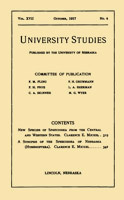University Studies of the University of Nebraska
Date of this Version
10-1962
Citation
University of Nebraska Studies: New Series no. 27
Abstract
1 / Voluntary Associations in a Zone of Transition
This report is a study of formal voluntary associations in a zone of transition. It seeks information on the various kinds of voluntary organizations to be found in such an area, the characteristics of the members, the manner in which people become affiliated with organizations, and the functions that organizations serve for their members. The specific associations studied include such diverse groups as a neighborhood improvement council, an old-age club, and various children's associations. In this study such groups fall under the province of voluntary associations. That such groups are found in a zone of transition warrants special attention because it has been common to assume that formal associations are nonexistent or at a minimum in the slum, an assumption which has an important bearing on theory in urban sociology and ecology,
This study was initiated with the knowledge that groups had been formed in an interstitial area through the efforts of a community organizer. The organizations created through his efforts provided a focus for the problem, and the membership of these groups provided a major portion of the universe studied. Thus, it was known prior to the study that there were persons belonging to voluntary associations in the area. It was assumed, however, that an extensive network of organizational participation could be found in the area independent of the affiliations created by the professional community organizer. This assumption was borne out readily. A cursory examination of the total membership for the city of such diverse organizations as the YWCA, Boy Scouts, Veterans of Foreign Wars, and so forth, indicated that many of the persons who were members of these groups also inhabited the area mapped out for study.
Were the members of formal organizations in the slum similar to their counterparts who lived in the suburbs? For instance, were they likely to have relatively high educational achievement, to be Protestant rather than Catholic in faith, and be voters more often than nonvoters? Such questions were posed at the inception of the study. Still other questions concerned the similarities and differences between persons who became members of organizations created by the community organizer and persons living in the same slum area but affiliated with other voluntary associations. And in a different vein, did children who belonged to associations come from families where their parents had a tradition of association, or was parental affiliation incidental to a child's participation? To answer such questions and to formulate hypotheses for testing, this inquiry drew heavily from studies dealing with voluntary associations. The relation of such studies to the present work will be noted shortly.


Comments
Published by The University at Lincoln